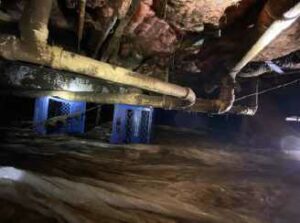As the summer months roll in, the furnaces get switched off and we turn to the air conditioning system (A/C). Many of us will need to repair the A/C unit as it has not been used all year round so it may need a quick service before we switch it on.
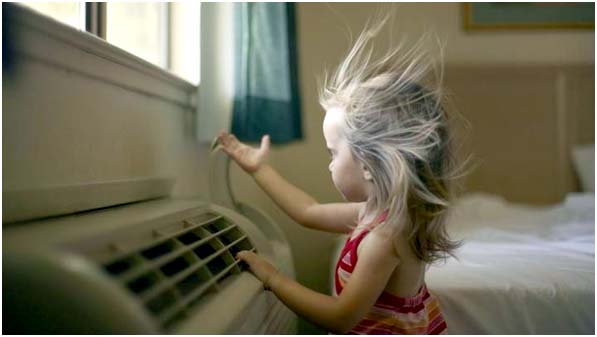
When the system fails and a heat spell is inbound we usually have to wait several days or even weeks for a technician to turn up to fix it, the costs are also quite steep. If you are comfortable with working around electricity you could save yourself some money as parts are pretty cheap for A/C units.
One such repair was on my own last summer where I spent $50 on parts and 2 hours of my time, I was quoted $255 from an A/C tech.
Assess The Problem & Diagnose
If you’re getting little or no cold air, check these three things first.
Make sure all the registers in the house are wide open. Then be sure the furnace filter is clean. Then go outside and clean off the condenser coils.
If several registers were closed or the filter was clogged, the reduced airflow could have caused the evaporator coil to ice up and stop cooling your home. If you’ve changed the filter and opened all the registers and you’re still not getting airflow at the registers, device the A-coil. Move the thermostat mode switch from “Cooling” to “Off” and move the fan switch from “Auto” to “On.” Let the blower run for at least 30 minutes or until there’s good airflow at the registers. Then turn the A/C back on to test it. If it works for the next 12 hours, you’ve solved the problem.
If the condenser coils are clogged, the compressor can overheat and shut down. You’ll experience intermittent periods of minimal cooling, followed by no cooling. Even if you’re “sure” the condenser coils are clean, clean them again. Turn off the power. Flip the A/C and furnace circuit breakers in your main electrical panel to the “Off” position. Next, turn off the power switch right at the furnace or air handler.
Then yank the disconnect block (Photo 1) and clean the condenser coils (Photo 2). If the A/C still doesn’t work properly after you’ve cleaned the condenser coils, installed a new filter, and opened all the supply vents, proceed with the following repairs.
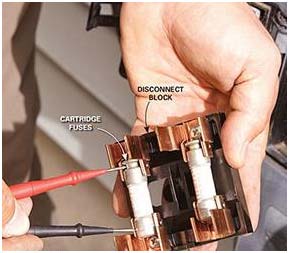
Test The Fuses
Set your multimeter to the lowest Ohms scale and touch the red and black leads to opposite ends of each fuse. If you get a numerical reading, the fuse is good. But a zero, a minus symbol, or an infinity symbol (∞) indicates a blown fuse.
Many disconnect blocks contain two cartridge fuses. Check them before you proceed with repairs. A blown fuse is a sign of a failing part inside the condensing unit. So don’t just replace it and think you’ve solved the problem. Instead, replace the parts we show here. Then install new fuses and fire up the unit. If it blows again, call a pro—you’ve got more serious issues.
Inspect The Access Panel
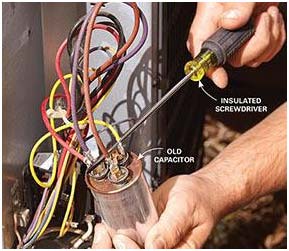
Remove the capacitor from the retaining bracket. Then touch an insulated screwdriver between the HERM (or “H”) terminal and the COMMON (or “C”) terminal. Do the same between the FAN (or “F”) terminal and the “C” terminal. On single-mode capacitors, just make a short between the two terminals.
Follow the electrical conduit from the house—that’s where you’ll find the access panel. With the power off, remove and store the access-panel retaining screws and remove the panel. Before you replace any parts, check for rodents’ nests or evidence of chewing on wires and electrical connectors. If you find broken wires or chewed insulation and can safely handle electrical repairs, discharge the capacitor first. Then repair the wires and clean out the nest. Otherwise, call a pro.
Installing A New Capacitor
Slide the new capacitor into the retaining bracket and tighten the bracket screw. Secure the wires with a zip tie.
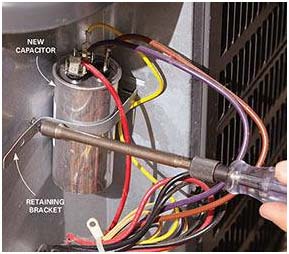
All A/C units have at least one capacitor. The capacitor stores electricity and releases it during compressor and condenser fan startup to give both motors an extra jolt of power. And it smooths out voltage fluctuations to protect the compressor and condenser fan motor from damage.
Capacitors can degrade slowly, providing less startup power over time. Or they can fail in an instant. Gradual capacitor failure can go unnoticed for a long time, stressing the compressor and condenser fan motor windings, resulting in their early failure. Since capacitors are cheap, it pays to proactively replace yours about every five years.
Replacing a capacitor is easy. Just take a photo of the wires before disconnecting anything (you may need a reference later on). Then discharge the stored energy in the old capacitor (Photo 4). Use needle-nose pliers to pluck one wire at a time from the old capacitor and snap it onto the corresponding tab of the new capacitor. The female crimp connectors should snap tightly onto the capacitor tabs. Wiggle each connector to see if it’s tight. If it’s not, remove the connector and bend the rounded edges of it so it makes a tighter fit on the tab. When you’ve swapped all the wires, secure the new capacitor.
WARNING: Discharge the capacitor before disconnecting wires or removing it from its bracket.



